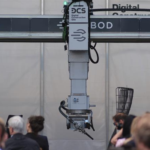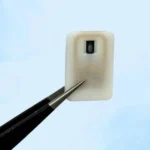Orbital Composites has been awarded an AFWERX Tactical Funding Increase (TACFI) contract to advance and scale the production of its Starfighter X modular unmanned aircraft system (UAS). This contract underscores the company’s innovative approach to aerospace manufacturing and brings its total government contract awards beyond $10 million.
The Starfighter X platform is built using Orbital Composites’ patented additive manufacturing compression molding (AMCM) process. This hybrid technology combines robotic, extrusion-based 3D printing with compression molding to create low-porosity composite parts. The AMCM process enables rapid production of complex aerospace components, positioning Orbital Composites at the forefront of high-performance UAS development.

Key Features of the Starfighter X Platform
The Starfighter X system offers several critical capabilities, making it an ideal solution for the evolving needs of national security and defense:
- – Automation: Orbital Composites utilizes robotic, autonomous manufacturing processes to mass-produce Starfighter X systems, reducing costs and lead times.
- – Modularity: The modular platform allows for rapid reconfiguration of drones, enabling a variety of types to be assembled from a common set of subsystems.
- – Speed: Two Starfighter variants are currently under development, with one capable of reaching speeds of 200 mph and another exceeding 300 mph.
- – Versatility: The system’s initial applications focus on counter-unmanned aerial systems (C-UAS) and cargo resupply missions, but it can be adapted for other critical missions.
- – Multi-mission Capability: Orbital’s manufacturing process supports the production of Group 1, 2, and 3 UAS, from small reconnaissance drones to larger tactical systems.
Scaled Production for National Security Needs
Orbital Composites’ AMCM process, known for its automotive-like cost efficiency and aerospace-grade performance, allows the company to scale production rapidly. The company’s ability to directly 3D print Starfighter aircraft, combined with its capacity to scale up to tens of thousands of airframes, positions it as a key player in the Department of Defense’s (DOD) Replicator initiative. This initiative aims to field thousands of autonomous systems within the next 12 to 18 months, a goal Orbital is well-suited to support.
“We built the factory first to tackle the challenges of scaled production,” says Amolak Badesha, co-founder and CEO of Orbital Composites. “While others focus on prototypes, we’ve invested in creating a factory capable of moving from concept to mass production in record time. This investment is now paying off as the DOD seeks rapid, scalable solutions.”
A Vision for the Future of Aerospace Manufacturing
Orbital Composites is not only focused on developing its own airframes but is also in discussions with prime contractors to support the production of larger, more advanced aerospace platforms. The company’s robotic, autonomous manufacturing processes could potentially play a pivotal role in both the Collaborative Combat Aircraft (CCA) program and the Pentagon’s broader goal of deploying autonomous systems at scale.
As Cole Nielsen, founder and CTO of Orbital Composites, explains: “I started Orbital to build the fastest helicopter ever made. Now, with the right machines and a factory built to scale, we’re ready to launch disruptive products like the Starfighter drones.”
Orbital’s innovations, driven by advanced 3D printing technologies, offer a new paradigm for aerospace manufacturing. With its scalable production capabilities and strategic alignment with DOD initiatives, Orbital Composites is poised to play a key role in the future of autonomous aerial systems.









